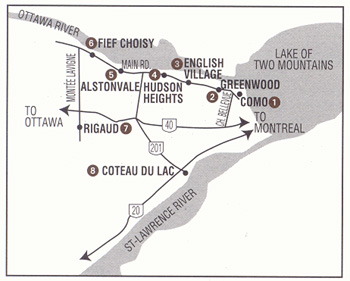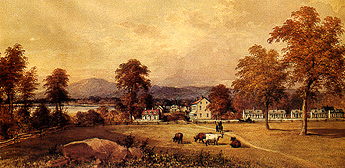 Intro
Intro
Peace between the Iroquois and New France cleared the way for the colony’s westward growth.
In the early 1700s, French colonists left fortified settlements near Montreal to clear new farms on the east tip of the land wedge between the Ottawa and St. Lawrence rivers.
Some came from Sainte-Anne-de-Bellevue and Pointe-Claire; others from the famous Sulpician mission village at Oka across the Lake of Two Mountains. Their descendants formed the nucleus of French society along the Ottawa’s south shore from historic Como Village to Rigaud.
In 1702, the King of France granted Vaudreuil seigneury to Philippe de Rigaud. It later passed to his son, Pierre de Cavagnal, before becoming the estate of Michel Eustache Gaspard Alain Chartier de Lotbinière. When France ceded Quebec to Britain in 1763, Hudson was known as the Cavagnal Concession, or simply Cavagnal, a range of seigneurial farm lots on the waterfront.
This Heritage Trail leads to historic settlements and landmarks in old Vaudreuil County where a small but active English-speaking community continues to thrive.
Among the first British settlers was a party of Hudson Bay Co. traders of Scottish stock who arrived around 1811 from Moose Fort on James Bay by way of the Ottawa River. In the 1820s colonists from England’s Cumberland district arrived to clear farms on the southeast flank of Rigaud Mountain, eventually moving to lands in present-day Hudson
GETTING THERE
From Montreal, take Autoroute 40 west and follow signs for Ottawa. Exit at Hudson and turn right onto Bellevue Road, which leads to the water. This tour follows Main Road, first cleared by French-speaking settlers nearly three centuries ago to string together scattered farmsteads along the winding shoreline. On this road trail-goers will find a wealth of impeccable French-colonial and Victorian homes.
 COMO
COMO
Site of one of Canada’s earliest glass industries, the historic village of Como is remembered by older residents of Hudson as the district between Pointe Cavagnal and Parsons’ Point on Lake of Two Mountains.
The Willows, or Willow Place Inn (1820), a reconstructed colonial manor at 208 Main Road is where François Xavier Desjardins ran his general store in the 1800s. Enjoy a pleasant meal here while watching the ferries shuttle between Como and Oka. Oka’s famous Calvary cross, a Catholic pilgrimage site built in 1739, attracts thousands of visitors each year.
English settlement in Hudson got a foothold in the early 1800s when Vaudreuil’s seigneur, Lotbinière, evicted a number of French-Canadian farmers for failing to pay him rent. One of the first to move in was a retired English army officer named John Mathison, who built the first schoolhouse in 1824.
Como was known by its postal address, Ottawa Glass Works, till the mid-19th century. It was renamed in 1855 to avoid confusion with the nation’s future capital. The factory specialized in window glass and telegraph insulators.
During its heyday, the village had its own stores, tradesmen and a striking stone church. St. Mary’s Anglican at 261 Main dates to Confederation, 1867 and still belongs to an active local congregation.
GREENWOOD
One of Hudson’s historic highlights is the Greenwood Centre for Living History, a well-preserved heritage home dating to the French Regime. Built on the lakeshore in the 1730s by voyageur Jean Baptiste Sabourin, Greenwood was sold in 1820 to John Mark Crank DeLesDerniers, a Nova Scotia-born merchant of Swiss-French descent who enlarged it as a residence and store.
House and furnishings were given to the community in 1994 by DeLesDerniers’ great-great granddaughter, Phoebe Hyde. Tours are offered to visitors most Sundays during the summer, by appointment.
Greenwood is in an area of historic Como informally dubbed Shepherd Village for a local riverboat captain and land owner named Robert Ward Shepherd.
Shepherd built many of the homes between Greenwood and St. Mary’s Church.
The social hub of early settlement at Como was Schneider’s Inn, a small stone building travelers still find at 264 Main Road. Built in 1792 as a residence, it became the home of William Schneider, a mercenary of German ancestry who served in the British army.
By the 1820s his inn catered to fur traders and other river travelers. It was a landing point for steamboats where farmers shipping produce to the city and local merchants gathered.
Greenwood, 254 Main Road: (450) 458-5396
ENGLISH VILLAGE (Hodgsonville)
Among the first Cumberland immigrants to settle in Vaudreuil was John Hodgson, who came with his wife and daughter to clear and farm a plot of land in Côte St-Charles in 1820. A cluster of houses between 288 and 302 Main Road sprang up around the Hodgson family sawmill, which operated along the waterfront between 1880 and 1965, and came to be known locally as English Village.
A short detour down Quarry Point Road leads to a rocky cape jutting into the water. A quarry on this land yielded the red sandstone blocks used to build many of Hudson’s fine stone structures, including St. James Anglican Church (1842) which can be seen at 642 Main Road.
HUDSON HEIGHTS
 A little further along, where Côte St-Charles and Main roads meet, visitors can see the old Mathison schoolhouse (586 Main Road). Centre of the early community, the house served over the years as courthouse, church, post office and store, and is regarded as Hudson’s oldest public building. The Mullan family operated a general store here for more than a century.
A little further along, where Côte St-Charles and Main roads meet, visitors can see the old Mathison schoolhouse (586 Main Road). Centre of the early community, the house served over the years as courthouse, church, post office and store, and is regarded as Hudson’s oldest public building. The Mullan family operated a general store here for more than a century.
With the advent of rail travel, Hudson gained fame as a retreat for English-speaking Montrealers. From the early 1900s to the 1960s, descendants of early French and English settlers lived alongside captains of commerce and industry drawn to Hudson’s tranquil waterfront.
One such figure was Thomas Basset Macaulay, a long-time president of the Sun Life Assurance Co. who took an avid interest in livestock breeding. From 1900 to 1942, Macaulay used his Hudson Heights estate to build up Quebec’s most famous herd of Holstein cows: Mount Victoria Farm was a 600-acre spread perched on Mt. Victoria Road, featuring an extensive complex of wooden barns and outbuildings as well as the Macaulay mansion, now owned by the Norris family.
Under expert guidance of leading herdsmen and farm managers, Mount Victoria cattle earned international acclaim. It’s estimated that the bloodlines of more than 90 per cent of purebred Holsteins in the world can be traced to this herd.
A golf course and elite housing development now sprawl over much of the original estate. The Holstein Association of Canada has erected a memorial cairn to Macaulay’s legacy at the corner of Main and Macaulay roads.
ALSTONVALE
The railway crossing below Macaulay’s Hill roughly marks the eastern boundary of Hudson’s Alstonvale district, which stretches west on both sides of Main Road for approximately four kilometres. Visitors interested in architectural heritage will admire St. James Church’s exquisite stonemasonry, the legacy of Orkney-born builder Robert Gray.
The name Alstonvale was chosen by descendants of the Cumberland settlers in the mid-1800s to designate the train-stop where local farmers delivered morning milk bound for Elmhurst Dairy in Montreal. Farms continued to operate through most of the 20th century, but Alstonvale is mainly a residential neighbourhood today.
FIEF CHOISY
Choisy, a former farmland district west of Alstonvale, supported generations of French and English-speaking families.
A number of Cumberland families were still farming here until the second half of the 20th century, when local agriculture declined. People flock to the area every Saturday during summer to buy and sell eclectic wares at Finnegan’s Market (775 Main Road), an outdoor rummage sale run by the Aird family.
Choisy comprised a 1,700-acre strip of rolling plains originally granted to a sister of the seigneur in 1768. In the 1820s, the Whitlock family ran a sawmill here providing settlers from Cavagnal and Côte St-Charles districts with a local market for timber.
John Whitlock was a Connecticut loyalist who left his country after the American Revolution and brought his family to Vaudreuil by way of Nova Scotia. His son William sided with Papineau’s Patriotes and was briefly jailed for inciting settlers to overthrow Lower Canada’s government during the 1837 Rebellion.
A number of homes in the vicinity of Montée Lavigne Road recall Quebec’s golden age of river traffic: the house at 898 Main Road belonged to a Montreal lumberman named William Graham who ran a nearby wharf for shipping logs. Muir’s Inn (903 Main Road) and the Lavigne House (910 Main) across the street both catered to steamboat passengers.
RIGAUD
The Trail leads through the old French town of Rigaud. On rue St-Pierre, note the rare twin bell towers of Rigaud’s magnificent Ste-Madeleine Church, decorated inside with imported Italian marble. Moulin Road leads to remnants of the seigneurial mill, a stone structure beside the Rigaud River.
Rigaud seigneury passed to an American named William Bingham, Lotbinière’s son-in-law, in 1829. Bingham granted 475 farms to English-speaking settlers in a nearby area called Côte St-Henri.
Before they were driven off by poor soil, a number of Irish families were among those who cleared farms on the south slope of Rigaud Mountain, forming a small colony on the St-Georges range. Today, chef Pierre Faucher, Quebec’s culinary coureur des bois, runs a large maple-sugar camp and restaurant featuring traditional Québécois cuisine, La Sucrerie de la Montagne.
COTEAU DU LAC FORT
National Historic Site
This site features an authentic British octagonal blockhouse and an early lock canal, said to be the first in North America, forerunner to the St. Lawrence Seaway. English-speaking settlers in Vaudreuil regarded Coteau du lac as their first home in the region. Next to it is the village’s old stone mill. To learn more about the development of river transportation, be sure to visit this national historic site operated by Parks Canada on the shore of the St.Lawrence. Head south on Route 201 to get there.
Coteau du lac Historic Site: (450) 763-5631
Other Resources:
Travelers may wish to purchase a copy of the illustrated guide, Main Road, Hudson: Then and Now to enrich their visit. Published by the Hudson Historical Society https://www.hudsonhistoricalsociety.ca/
This guide is presented by the Quebec Anglophone Heritage Network. The Heritage Trail series is made possible by funding from the Department of Canadian Heritage and Economic Development Canada. Space constraints preclude mention of all possible sites. Thanks to Maben Poirier, Pat Caffrey, W. Lambert Gardiner and Kevin O’Donnell of the Hudson Historical Society for their help. For more information call the QAHN office at (819) 564-9595 or toll free within Quebec at 1 (877) 964-0409).
![]()
![]()